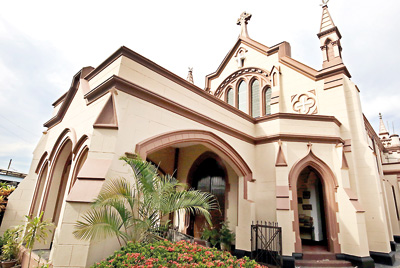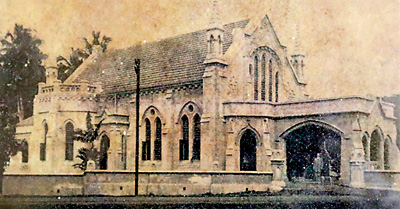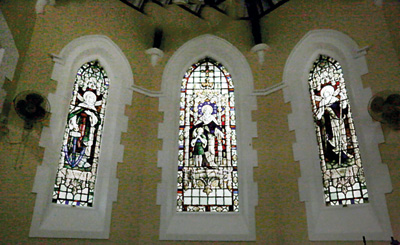Sunday Times 2
Regent Street Christian Reformed Church: Century of togetherness and unity
 Neat little blue and white road indicators won’t get you to Regent Street. Neither will you find it on a map of Colombo 10. If anything you would discover that this passage along the Accident Wing of the National Hospital is now called E.W. Perera Mawatha. Surviving this obvious change and many less noticed ones stands the Regent Street Christian Reformed Church (CRC), previously known as the Dutch Reformed Church, as it did for the past 100 years.
Neat little blue and white road indicators won’t get you to Regent Street. Neither will you find it on a map of Colombo 10. If anything you would discover that this passage along the Accident Wing of the National Hospital is now called E.W. Perera Mawatha. Surviving this obvious change and many less noticed ones stands the Regent Street Christian Reformed Church (CRC), previously known as the Dutch Reformed Church, as it did for the past 100 years.
Sitting snugly next to the Presbyterian Girls’ School, Regent Street Church is located along the busier side of Norris Canal Road and its humble façade doesn’t command attention. An observant few would dismiss scaffolding around the entrance as Christmas, but the preparations are for December 22 – the church’s centenary.
Inside these thick walls consecrated in December 1915, little has changed since a century ago. “We’ve had to do some renovations from 2009 to 2011,” a senior member of the congregation, Helene de Rosayro tells us. Asbestos sheets replace the roofing tiles and wooden beams supporting the ceiling had lived-out their purpose. Thin metal framing on individual blocks of glass on each window have been a harder task to match and replace she says. The dainty metal work is in line with suspended lamp stands, twisted in elegant swirls.
Rev. S. Nelson, who currently overlooks the English and Tamil congregations has served at Regent Street for two years. Captivated by the Church’s Romanesque architecture he feels it’s among the better preserved premises of the CRC.
Regent Street is perhaps one of the few remaining orthodox CRC Consistories. In true reformist fashion a wooden pulpit is visible from anywhere within the church. “It represents the prominence placed on the Word” says Deacon Hilary Moore. Originally from Regent Street’s sister Consistory in Maligakanda, he says this prominence inspired hour-long Sunday sermons he sat through as a child.
 “I also remember in the 40′s and 50′s ladies of the congregation turned-up in gloves, hats and often “had an outfit tailored for each week.” A gentleman residing in Maradana made hats to measure, making stops along the parishioners’ homes to pick-up orders he recalls. “Another must” for the ladies’ Sunday best were nylon stockings.
“I also remember in the 40′s and 50′s ladies of the congregation turned-up in gloves, hats and often “had an outfit tailored for each week.” A gentleman residing in Maradana made hats to measure, making stops along the parishioners’ homes to pick-up orders he recalls. “Another must” for the ladies’ Sunday best were nylon stockings.
Former worshipper, Langston Joseph remembers being thrilled as a child during annual Military Day services. During the time of Rev. D. Evan Joseph who also served as the Military Padre, regimental bands ceremoniously marched down Norris Canal Road leading in infantry for the service.
Where one would ordinarily expect to find an altar, at the front of a church is the choir-stall. Once again, this is testament to a heavy importance placed on scriptures alone void of all the frills we’re told. Before Helene was old enough to take her current seat at the piano, her father as Church Secretary “which was then called a Scriba. Like many children in the parish today, she was introduced to the three figures in the stained-glass panels behind the choir-stall depicted “Faith, Hope and Charity.”
 Embodying the spirit of the congregation, these three virtues are the cornerstones on which Regent Street’s Church now stands. Initial worshippers here, were patrons of the Maligakanda Consistory which gathered every Sunday in what was known as Palm House. According to the writings of Douglas Franciscus in ‘The Faith of Our Fathers’, Rev. L. A. Joseph recognised that this premises didn’t suffice to serve “the needs of the congregation” in February, 1914. The estimated cost to put-up a new church was Rs. 35,000, to be raised upon selling Palm House. Designed by W. Claessen, construction in Regent Street started off in December 1914. The need to sell Palm House never arose, owing to the generosity of parishioners.The baptismal font, pulpit bible, stained glass, hymn books are just a few of the generous offerings.
Embodying the spirit of the congregation, these three virtues are the cornerstones on which Regent Street’s Church now stands. Initial worshippers here, were patrons of the Maligakanda Consistory which gathered every Sunday in what was known as Palm House. According to the writings of Douglas Franciscus in ‘The Faith of Our Fathers’, Rev. L. A. Joseph recognised that this premises didn’t suffice to serve “the needs of the congregation” in February, 1914. The estimated cost to put-up a new church was Rs. 35,000, to be raised upon selling Palm House. Designed by W. Claessen, construction in Regent Street started off in December 1914. The need to sell Palm House never arose, owing to the generosity of parishioners.The baptismal font, pulpit bible, stained glass, hymn books are just a few of the generous offerings.
For many, memories of Regent Street include the now abandoned practice of learning-up the Heidelberg Catechism, acting in Sunday school plays and visiting the Accident Ward to pray for the wounded. Currently though, many older members of the Consistory are scattered both here and abroad. “We still have people coming to church from as far as Negombo,” Helene says. “It’s what I love about this church” Hilary shares. “There is a togetherness and unity” that has survived just as long.

